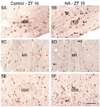Neural activation in arousal and reward areas of the brain in day-active and night-active grass rats
- PMID: 19837140
- PMCID: PMC2849298
- DOI: 10.1016/j.neuroscience.2009.10.019
Neural activation in arousal and reward areas of the brain in day-active and night-active grass rats
Abstract
In the diurnal unstriped Nile grass rat (Arvicanthis niloticus) access to a running wheel can trigger a shift in active phase preference, with some individuals becoming night-active (NA), while others continue to be day-active (DA). To investigate the contributions of different neural systems to the support of this shift in locomotor activity, we investigated the association between chronotype and Fos expression during the day and night in three major nuclei in the basal forebrain (BF) cholinergic (ACh) arousal system - medial septum (MS), vertical and horizontal diagonal band of Broca (VDB and HDB respectively) -, and whether neural activation in these areas was related to neural activity in the orexinergic system. We also measured Fos expression in dopaminergic and non-dopaminergic cells of two components of the reward system that also participate in arousal - the ventral tegmental area (VTA) and supramammillary nucleus (SUM). NAs and DAs were compared to animals with no wheels. NAs had elevated Fos expression at night in ACh cells, but only in the HDB. In the non-cholinergic cells of the BF of NAs, enhanced nocturnal Fos expression was almost universally seen, but only associated with activation of the orexinergic system for the MS/VDB region. For some of the areas and cell types of the BF, the patterns of Fos expression of DAs appeared similar to those of NAs, but were never associated with activation of the orexinergic system. Also common to DAs and NAs was a general increase in Fos expression in non-dopaminergic cells of the SUM and anterior VTA. Thus, in this diurnal species, voluntary exercise and a shift to a nocturnal chronotype changes neural activity in arousal and reward areas of the brain known to regulate a broad range of neural functions and behaviors, which may be also affected in human shift workers.
Figures








References
-
- Asmus SE, Newman SW. Colocalization of tyrosine hydroxylase and Fos in the male Syrian hamster brain following different states of arousal. J Neurobiol. 1994;25:156–168. - PubMed
-
- Balfour ME, Yu L, Coolen LM. Sexual behavior and sex-associated environmental cues activate the mesolimbic system in male rats. Neuropsychopharmacology. 2004;29:718–730. - PubMed
-
- Bina KG, Rusak B, Semba K. Localization of cholinergic neurons in the forebrain and brainstem that project to the suprachiasmatic nucleus of the hypothalamus in rat. J Comp Neurol. 1993;335:295–307. - PubMed
-
- Blanchong JA, McElhinny TL, Mahoney MM, Smale L. Nocturnal and diurnal rhythms in the unstriped Nile rat, Arvicanthis niloticus. J Biol Rhythms. 1999;14:364–377. - PubMed
Publication types
MeSH terms
Substances
Grants and funding
LinkOut - more resources
Full Text Sources
Miscellaneous

